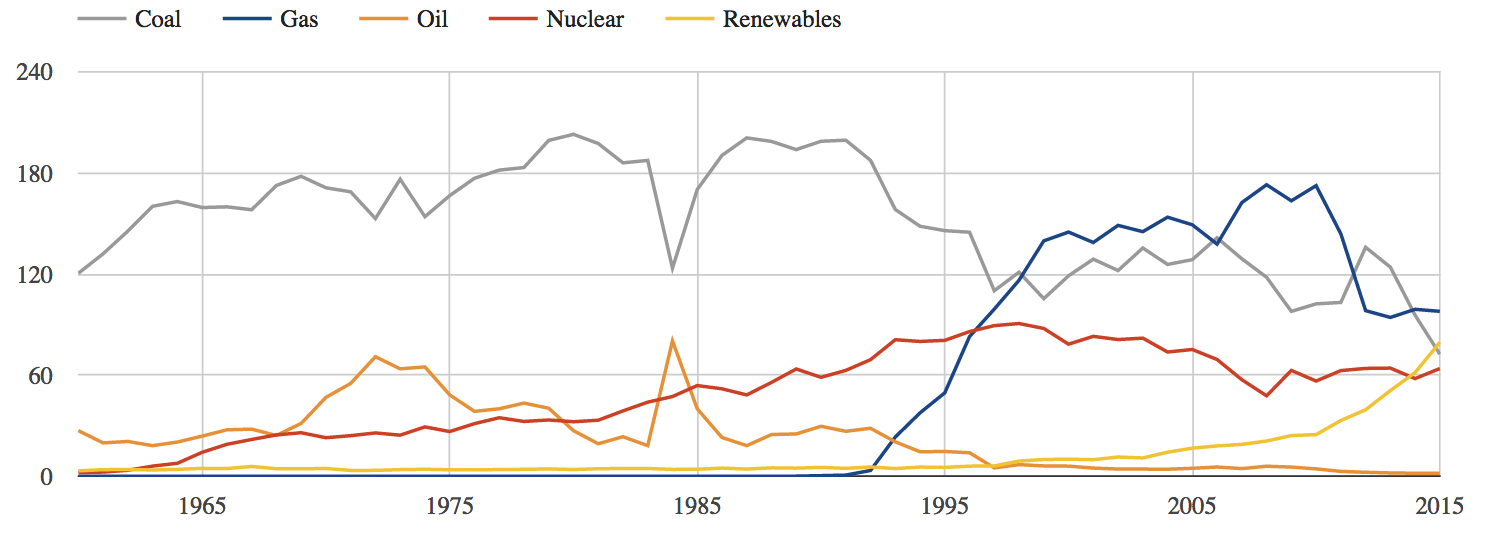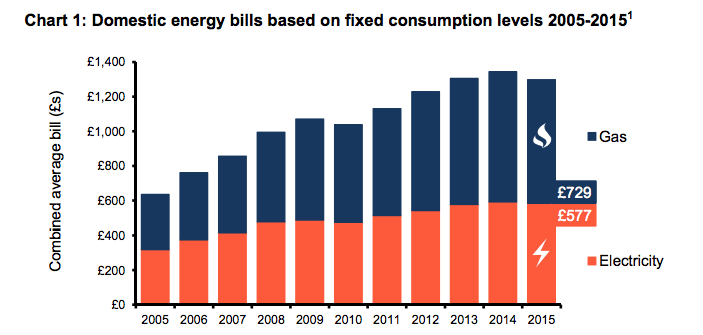
UK emissions lowest since the 1920s as renewables overtake coal
Simon Evans
03.31.16Simon Evans
31.03.2016 | 3:39pmUK CO2 emissions fell to their lowest level since the 1920s last year as renewables generated more electricity than coal for the first time ever, provisional statistics from the Department of Energy and Climate Change (DECC) show.
The figures, showing a 4.1% reduction in CO2 emissions between 2014 and 2015, confirm Carbon Brief analysis published last month, which estimated a 4.3% fall. DECC also reports a 3.3% reduction in UK greenhouse gas emissions in 2015.
Carbon Brief has extracted the key figures from the latest DECC data.
Victorian emissions
Last year’s drop in emissions takes UK CO2 output to 405 million tonnes (Mt), the lowest level since the economic seizures caused by the 1920s general strikes. The last time UK CO2 emissions were consistently as low as in 2015, Queen Victoria sat on the throne.
UK CO2 emissions 1850-2015

UK CO2 emissions (millions of tonnes) between 1850 and 2015. Source: DECC and the World Resources Institute CAIT data explorer. Chart by Carbon Brief. The CAIT data has been adjusted because it excludes land use emissions.
UK greenhouse gas emissions in 2015 were down 3.3%, to 497MtCO2 equivalent. This is the lowest level in at least 65 years; longer records are not available. It leaves UK emissions 38% below 1990 levels.
The third carbon budget for 2018-2022 calls for a 35% reduction. This comparison is only indicative however. Carbon budget accounting uses a complicated approach that makes direct comparisons impossible.
Coal collapse
Last year’s reduction in emissions was almost entirely down to a continuing collapse in coal burning, particularly in the electricity sector. Coal-fired power generation in 2015 fell to its lowest level since the 1950s, down 24% since 2014 and 47% since 2012. EnAppSys, an energy service provider, says coal generation is the lowest since 1951.
UK electricity generation by source, 1960-2015

UK electricity generation by source, 1960-2015, terawatt hours. Source: DECC energy trends table 5.1 and historical electricity data. Chart by Carbon Brief.
Overall, UK coal consumption is at its lowest level in more than 150 years as railways, factories, homes and gasworks no longer use it. More recent factors weighing on demand include half of Drax, the UK’s largest power station, being converted to burn wood pellets instead of coal.
Changes in the relative wholesale price of coal versus gas, an increase in the UK’s carbon tax last April, the closure of the SSI steelworks in Redcar, the rise of renewables and a rebound in nuclear output all contributed to the reduction in coal use in 2015.
Several coal plants have closed this year, suggesting the fall in coal use will continue in 2016.
Record renewables
The fall in coal generation combined with a large increase in renewable electricity output means, for the first time ever, green energy is now the UK’s second-largest power source. Renewables supplied 25% of the electricity generated in the UK last year, a record high share.
Renewables’ share of generation was up from 19% in 2014, an increase of nearly a third. Within that, the largest increases were for solar, up 87%, and biomass, up 44%. In total, renewable output has more than tripled since 2010.
UK renewable electricity generation by source, 2009-2015

UK renewable electricity generation by source, 2009-2015, terawatt hours. “Other” includes landfill gas, energy from waste, anaerobic digestion, sludge digestion and biomass co-firing. The latter is no longer significant. Source: DECC energy trends section six. Chart by Carbon Brief.
Combined with nuclear, the latest DECC figures show that low-carbon supplies accounted for 46% of UK generation in 2015, also a record high.
Falling bills
The record high for renewables and collapsing coal use last year was accompanied by the first reduction in household energy bills since 2010.

Source: DECC special feature on domestic energy bills.
The reduction in bills reflects a combination of a longer-term trend towards lower household energy demand and the shorter-term impact of falling energy prices, following the collapse in oil prices.
Cheap oil
The large drop in coal-related CO2 masked an increase in emissions from transport, up 1.4% last year as cheap oil led to more driving. In fact, transport emissions in 2015 were just 1% below 1990 levels.
UK transport CO2 emissions 1990-2015

UK transport CO2 emissions 1990-2015, millions of tonnes. Source: DECC. Chart by Carbon Brief.
Transport accounted for 29% of UK CO2 emissions in 2015, the second-largest source after electricity generation. The lack of progress in reducing transport emissions means the sector is claiming an ever-increasing share of the UK total.
One reason is the growing gap between car CO2 standards and emissions in the real world. This has prompted speculation as to whether Volkswagen-style “defeat devices” have been used more widely in the car industry.
Residential emissions — mainly from home heating — also increased last year. This was largely because it was slightly cooler than 2014, which was the UK’s hottest year on record.
The UK will need to cut emissions across the whole economy if it is to meet its longer-term carbon targets, according to the Committee on Climate Change.

